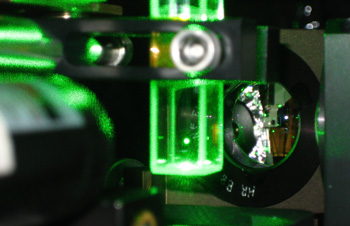A century after Albert Einstein said we would never be able to observe the instantaneous velocity of tiny particles as they randomly shake and shimmy, so called Brownian motion, physicist Mark Raizen and his group have done so.
 AUSTIN, Texas—A century after Albert Einstein said we would never be able to observe the instantaneous velocity of tiny particles as they randomly shake and shimmy, so called Brownian motion, physicist Mark Raizen and his group have done so.
AUSTIN, Texas—A century after Albert Einstein said we would never be able to observe the instantaneous velocity of tiny particles as they randomly shake and shimmy, so called Brownian motion, physicist Mark Raizen and his group have done so.
“This is the first observation of the instantaneous velocity of a Brownian particle,” says Raizen, the Sid W. Richardson Foundation Regents Chair and professor of physics at The University of Texas at Austin. “It’s a prediction of Einstein’s that has been standing untested for 100 years. He proposed a test to observe the velocity in 1907, but said that the experiment could not be done.”
In 1907, Einstein likely did not foresee a time when dust-sized particles of glass could be trapped and suspended in air by dual laser beam “optical tweezers.” Nor would he have known that ultrasonic vibrations from a plate-like transducer would shake those glass beads into the air to be tweezed and measured as they moved in suspension.
Raizen’s research, published in Science, is the first direct test of the equipartition theorem for Brownian particles, one of the basic tenets of statistical mechanics. It is also a step toward cooling glass beads to a state in which they could be used as oscillators or sensors.
The equipartition theorem states that a particles’ kinetic energy—the energy it possesses due to motion—is determined only by its temperature, not its size or mass.
Raizen’s study now proves that the equipartition theorem is true for Brownian particles; in this case, glass beads that were three micrometers across.
Raizen says he and his colleagues can now push the limits, moving the particles closer to a quantum state for observation.
“We’ve now observed the instantaneous velocity of a Brownian particle,” says Raizen. “In some sense, we’re closing a door on this problem in physics. But we are actually opening a much larger door for future tests of the equipartition theorem at the quantum level.”
There, he expects that equipartition theory will break down, leading to new problems and solutions surrounding the quantum mechanics of smallparticles composed of many atoms.
Raizen’s coauthors are Tongcang Li, Simon Kheifets and David Medellin of the Center for Nonlinear Dynamics and Department of Physics at The University of Texas at Austin.
Contact: Dr. Mark Raizen, professor of physics, 512-471-4753; Lee Clippard, public affairs, 512-232-0675.

















Comments 29
So Einstein was wrong about how far science would advance. I am shocked!!! Throw out everything he ever did!!! lol. Lighten up people it is just a title to a article.
This is Very cool!! Thank you!
how does this measure BROWNIAN motion?
the Laser and the ultrasound are imparting forces on the particles so it is not measuring pure Brownian motion. it is measuring the sum of brownian and laser induced and transducer induced motions right? It's like saying you are measuring coasting speed of a car while you are both pushing it with another car and hitting the brakes too.
Furthermore they don't explain in the article how there are actually measuring the INSTANTANEOUS motion of whatever motion they are measuring.
They also don't tell us what technique they use actually to measure the motion - only how they hold the particles in suspension.
They also don't tell us how they integrate the sensor data which much have a determinate time scale of measurement and convert that to an infinitely small range of measuring time to get "instantaneous" motion.
further explanations are appreciated.
vivzizi
This is an interesting news story, although I take issue with the headline. It irritates me how journalists and some scientists feel they have to resort to negative name-dropping, all in a feeble attempt at sensationalising a scientific discovery. Surely, if such things are able to stand by their own merit, the invocation of dead men is gratuitously unnecessary. It irks we when I see Darwin's name also used in this way.
Thank you vivzizi
I felt the same thing that you said. They added information that wouldn't be there normally .
How many of you would have stopped and read the article if it had been titled something less glaring? What a level humans have sunk to!
Einstein was a genius but he was a human being so he could make mistakes.
Wait... didn't they prove Einstein's theory was correct?
@vivzizi
I don't think they mentioned anything about measuring the speed of the particle... rather they just successfully setup the apparatus to observe the motion of the bead.
But i agree with the part about it being an observation of a simulation of the natural Browninan motion but I am no expert at that